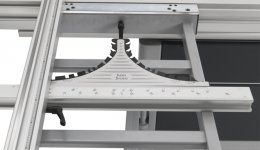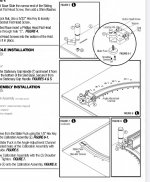smorgasbord
Member
- Joined
- Jan 7, 2022
- Messages
- 1,059
So, I'm watching yet another woodworking video (still away from my shop for another week), and the guy is using a Woodpecker's AutoScale miter sled. He's got a sacrificial wood block at the end, kind of like what I did on my miter saw some month's ago, but when I looked at the Woodpecker's site/video, their claim to fame is that fence pivots around a point on the edge of the kerf, so the ruler on top remains accurate at any angle.
Video here:=1s
Still frame here:
[attachimg=1]
My question is: How did they do this? I've looked at the sled base, and it has a few round holes, but nothing that itself slides or arcs, so there must be something in the fence. I haven't yet done a patent search, but perhaps that's next?
Anyone have this? It's, as expected, quite expensive, and won't fit my Inca tablesaw, so I'm looking to see if the pivot mechanism is something I can replicate for my own use.
Video here:=1s
Still frame here:
[attachimg=1]
My question is: How did they do this? I've looked at the sled base, and it has a few round holes, but nothing that itself slides or arcs, so there must be something in the fence. I haven't yet done a patent search, but perhaps that's next?
Anyone have this? It's, as expected, quite expensive, and won't fit my Inca tablesaw, so I'm looking to see if the pivot mechanism is something I can replicate for my own use.



